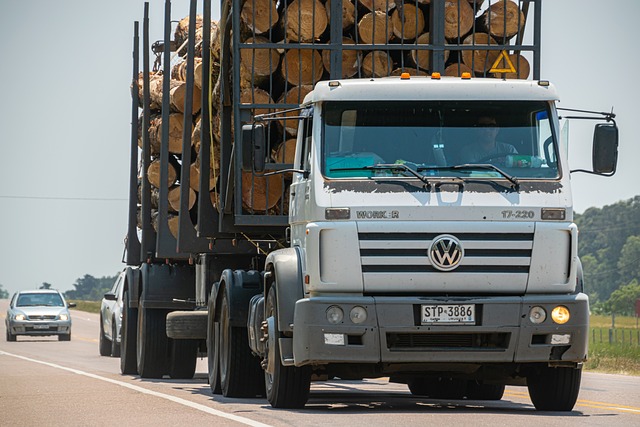Navigating the intricacies of truck maintenance can be daunting, yet indispensable for ensuring your vehicle’s reliability. A fundamental aspect of this upkeep is understanding and managing your truck’s battery system. This beginner’s guide demystifies the process of recognizing when a truck battery replacement is necessary and provides a clear, step-by-step approach to selecting and installing a new one. Whether you’re an owner-operator or a fleeting manager, mastering this task will empower you with the knowledge to maintain your truck’s electrical health. Dive into the essentials of truck battery replacement and keep your rig ready for the road.
- Understanding Your Truck's Battery System: The Basics for Beginners
- Signs It's Time to Replace Your Truck Battery
- Step-by-Step Guide to Safely Removing Your Old Truck Battery
- Choosing the Right Battery for Your Truck: Factors to Consider
- How to Install a New Battery in Your Truck: A Comprehensive Walkthrough
Understanding Your Truck's Battery System: The Basics for Beginners

When addressing your truck’s battery system, it’s crucial to grasp the fundamental components and their functions to ensure a smooth operation on the road. A typical truck battery is a 12-volt lead-acid battery, which is responsible for starting your engine and powering electrical systems during operation. For beginners, understanding the different types of truck batteries available is the first step. There are three main types: conventional, absorbed glass mat (AGM), and enhanced flooded (EFB). Conventional batteries are the most affordable but require careful maintenance to prevent sulfation. AGM batteries offer a spill-proof design and more consistent performance across various temperatures. EFB batteries are designed with built-in charging technology that maintains optimal battery performance and reduces maintenance.
Another key aspect to consider is the group size of your truck battery, which must match the vehicle’s specifications. This determines the physical dimensions and is crucial for a proper fit. Additionally, check the cold cranking amps (CCA) rating to ensure the battery can start your truck in cold weather conditions. The reserve capacity (RC) is also important; it measures how many minutes the battery can supply essential current at 25 amps without falling below 1.75 volts per cell. Regular maintenance, such as cleaning corrosion from terminals and checking the water level in flooded batteries, helps extend the life of your truck battery. Always refer to your vehicle’s owner’s manual for specific recommendations regarding compatible batteries and installation procedures. Understanding these basics will empower you to make informed decisions when selecting or replacing a truck battery, ensuring that your investment is well-protected and your truck’s electrical systems are reliable.
Signs It's Time to Replace Your Truck Battery

When your truck’s battery shows signs of wear or malfunction, it’s crucial to address the issue promptly to avoid unexpected vehicle disruptions. A key indicator that your truck battery may need replacement is a consistently sluggish engine crank. If you notice that your truck takes longer than normal to start, especially on cold mornings, this could be a sign of reduced capacity in the battery. Another significant sign is if the battery warning light illuminates on the dashboard; this often points to a charging system problem or a failing battery. Regular maintenance, such as checking the battery’s voltage with a multimeter, can help you identify when the charge falls below the manufacturer’s recommended level, typically around 12.4 volts for a fully charged lead-acid truck battery. Additionally, visible signs of corrosion on terminals and cables, or if the battery is more than three years old (or past its expiration date), it may be time to consider a replacement. Regularly inspecting these components can prevent unexpected failures and ensure your truck’s reliability. Lastly, if you’ve had to jump-start your truck multiple times within a short period, or the headlights are dimmer than usual, these are clear indications that your truck battery’s life span is nearing its end, and it should be replaced. Keep in mind that environmental factors such as extreme temperatures can also affect battery performance, making regular checks and replacements even more essential for maintaining your truck’s optimal operational status.
Step-by-Step Guide to Safely Removing Your Old Truck Battery

When it’s time to replace your truck battery, safety and precision are paramount. The process of removing an old battery from your vehicle should be executed with care to avoid any damage to the truck or injury to yourself. Begin by parking your truck on a level surface and ensuring that you have all the necessary tools at hand—a wrench or socket set, gloves, eye protection, and a clean cloth or tray to manage any acid spillage. Always start by safely disconnecting the battery. Locate the negative (-) terminal first, as this is the standard procedure. Use your wrench to loosen and remove the nut that secures the negative cable clamp to the battery post. Carefully lift the cable off the post and place it aside, ensuring that it does not touch any metal parts of the truck frame or other components, as this could create a short circuit. Repeat this process for the positive (+) terminal, removing its nut and cable last.
Now that the cables are disconnected, your truck battery is ready to be extracted. Take note of any mounting brackets or hold-down clamps securing the battery in place. Depending on your truck model, you may need to release these mechanisms before sliding the battery out. Once all connections are securely disconnected and the mounting hardware is removed, you can carefully lift the battery out of its compartment. It’s heavy, so take your time and ask for help if needed to avoid strain or accidental drops. Once removed, inspect the battery tray for any corrosion or damage that could interfere with the installation of a new battery. Properly disposing of or recycling the old battery is the final step before you install the new one, ensuring your truck’s electrical system is ready to perform optimally with renewed power.
Choosing the Right Battery for Your Truck: Factors to Consider

When it comes time to replace your truck’s battery, selecting the right one is paramount for reliability and performance. Truck batteries come in various sizes and types, and understanding your specific needs will ensure you choose the optimal model. Firstly, consider the make and model of your truck; not all batteries are compatible with every vehicle. Consult your owner’s manual or the manufacturer’s recommendations to determine the correct battery group size for your truck. Additionally, think about your typical driving conditions, such as the climate you primarily operate in. Extreme temperatures can affect battery life, so a high-quality battery designed to perform well in your local environment will be more durable and reliable.
Another important factor is the type of battery that suits your needs. Trucks often require heavy-duty batteries due to their larger size and the demands placed on the electrical systems, such as additional lighting, power inverters, or advanced audio systems. Look for a truck battery with a high cold cranking amps (CCA) rating if you live in a cooler region to ensure your engine starts efficiently in winter conditions. Conversely, a battery with a good reserve capacity (RC) is ideal for areas with high temperatures and humidity where the battery can overcharge and self-discharge more rapidly. Lastly, consider the warranty and service reputation of the battery manufacturer. A robust warranty can provide peace of mind and protect your investment in case of unexpected issues. Remember to replace your truck’s battery every few years, as battery performance degrades over time, which can lead to unwanted downtime when you need your truck most.
How to Install a New Battery in Your Truck: A Comprehensive Walkthrough

When it comes time to replace the battery in your truck, a task that typically occurs every few years, it’s important to perform the installation with precision and care. Begin by gathering all necessary tools and equipment, including the new truck battery, socket set, wrench set, wire cleaners or brushes, a multimeter for testing, and safety gear such as gloves and eye protection. Ensure your work area is well-lit and accessible.
Start by safely securing the truck to prevent any unintended movement during the process. Locate the old battery and take note of its connections: positive (red) and negative (black) terminals, along with any additional cables that may connect to it. Disconnect the negative terminal first to prevent any electrical current from flowing through the wrench you will use to remove the bolt, which could result in a spark or short circuit. Next, disconnect the positive terminal in the same manner. Remove the battery hold-down clamp and any mounting bolts that secure the battery to the truck chassis. Lift the old battery out carefully and set it aside for disposal or recycling according to local regulations.
Position the new truck battery in place, ensuring it is properly aligned with the battery tray. Reattach the mounting bolts and tighten them to the manufacturer’s specifications. Once the battery is securely mounted, reconnect the positive terminal first, followed by the negative terminal. Make sure all connections are tight and corrosion-free. Use a multimeter to verify that the battery is holding a charge as expected.
Finally, clean any corrosion from old terminal connections and apply anti-corrosion paste to the terminals of the new battery. This step helps to prevent future issues with battery connection integrity. Double-check all connections, ensure the battery is fully seated in its holder, and secure any loose cables or wires. Your new truck battery should now be successfully installed, ready to provide reliable power for your vehicle’s electrical systems. Always consult your truck’s owner manual for specific instructions tailored to your vehicle’s make and model.



